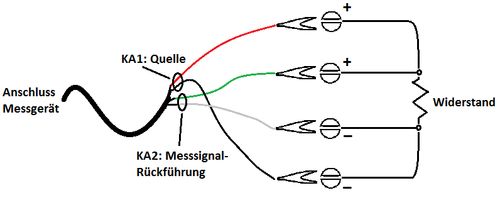Four-wire measurement
RIO GmbH determines resistance R and specific resistance ρ using the four-wire measurement. This method is usually used when conductor and connection resistance can influence or distort the measurement. A defined electrical current I flows through two of the four wires attached to the test object. The voltage sloping of the resistance of the test object is picked up via the two other lines and the potential difference is determined. If the current by the voltage meter and the voltage drop within the measuring cables are negligible, the resistance is obtained directly from Ohm's law.
Consequently, the specific electrical resistance ρ can be determined by measuring the electrical resistance R in combination with knowledge of the geometry of the test object, i.e., the cross-sectional area A and length l.
The specific electrical conductivity σ is the reciprocal quantity of the electrical resistivity ρ.
Determination of a blank value enables the determination of the specific characteristics of the measuring equipment which will be subtracted from the measurement results in order to achieve precise results for the characteristics of the sample.
The four-wire measurement is primarily used to determine very low resistances, where the resistance of the leads or contacts can no longer be neglected:
⇒ Contact resistance on connectors in frictional corrosion tests (µΩ - Ω)
⇒ Determination of material properties of magnets (Ω mm2/m)
⇒ Resistance measurements on samples with conversion layers before and after corrosion tests
(MIL-DTL-5541)











